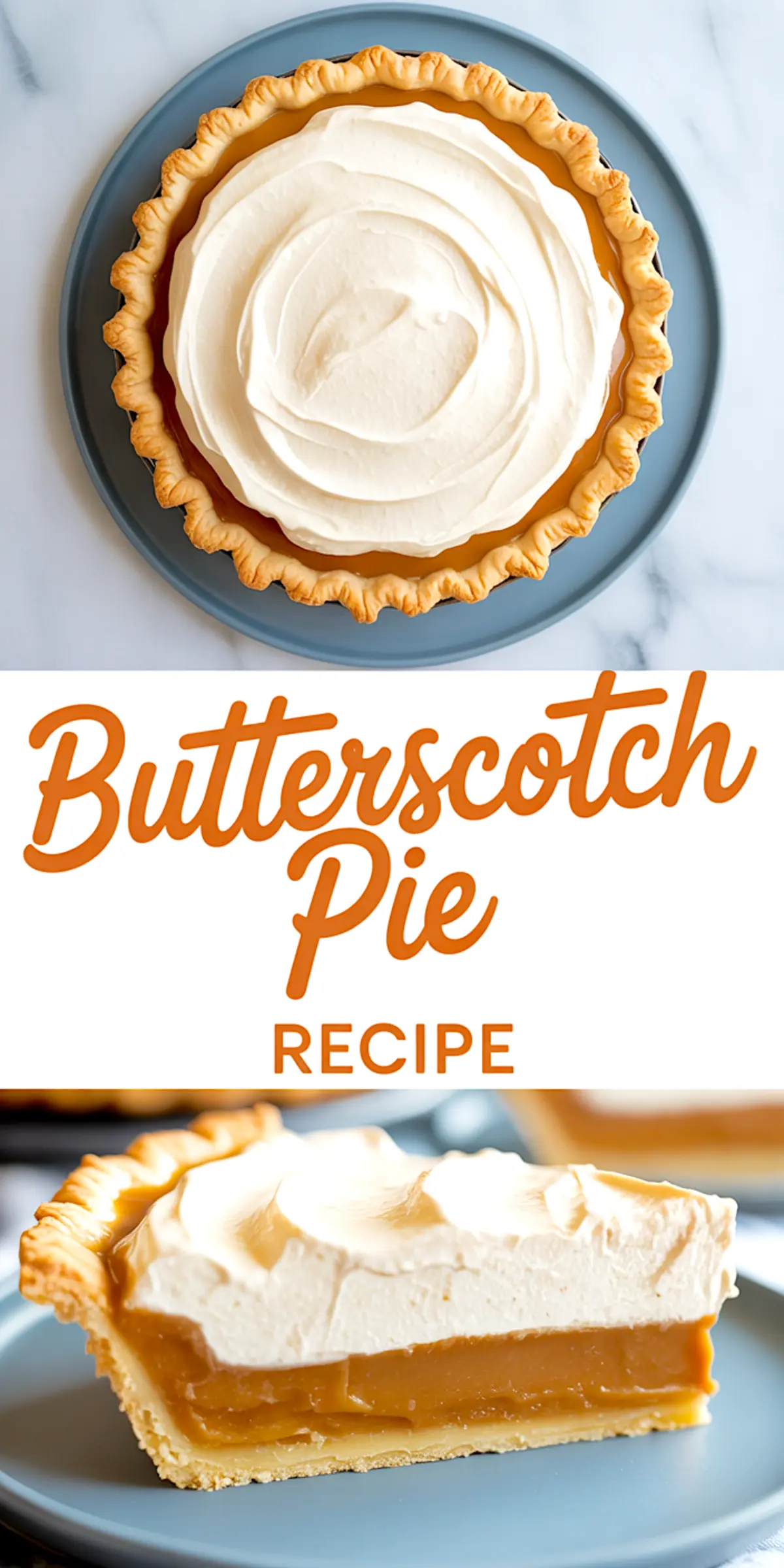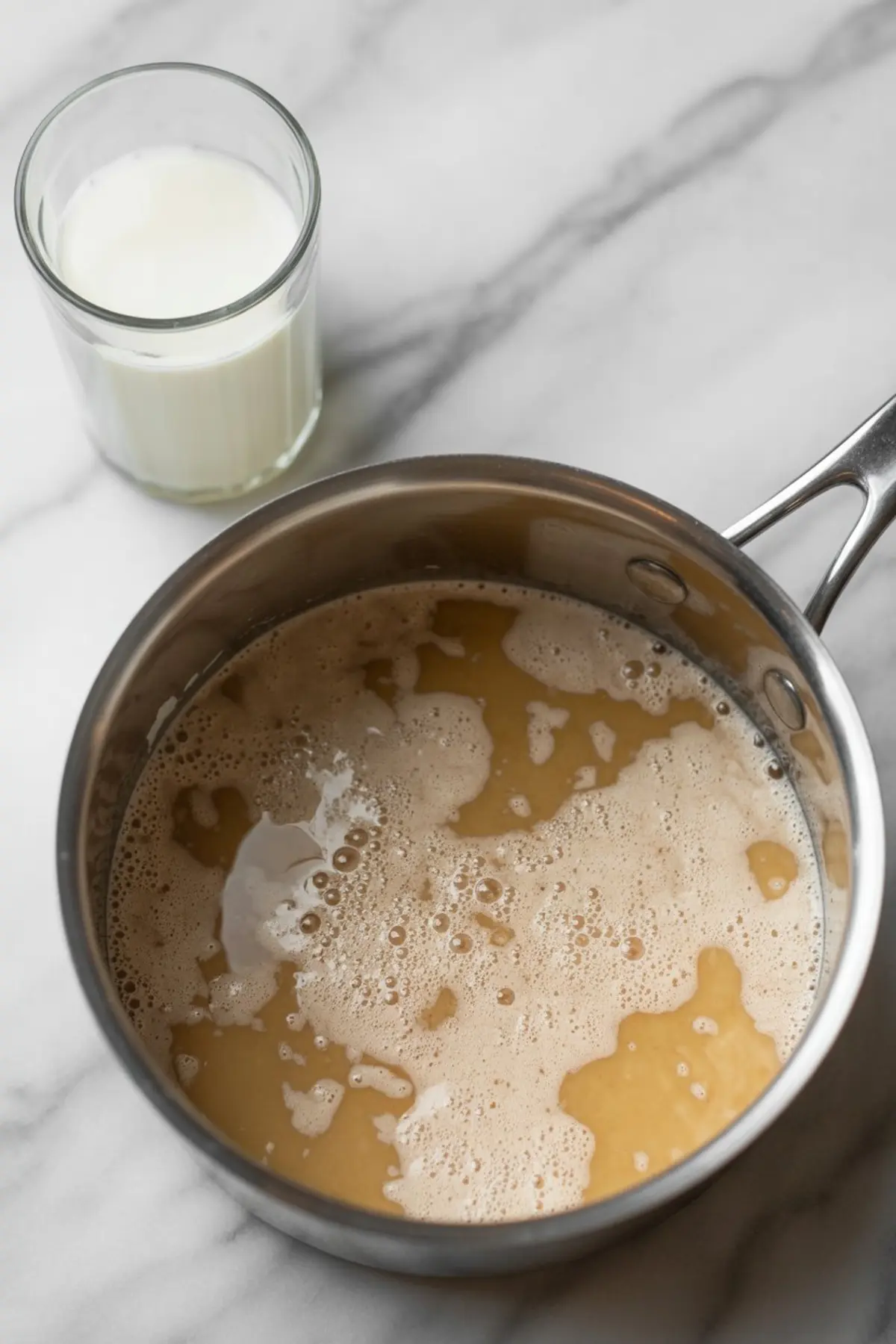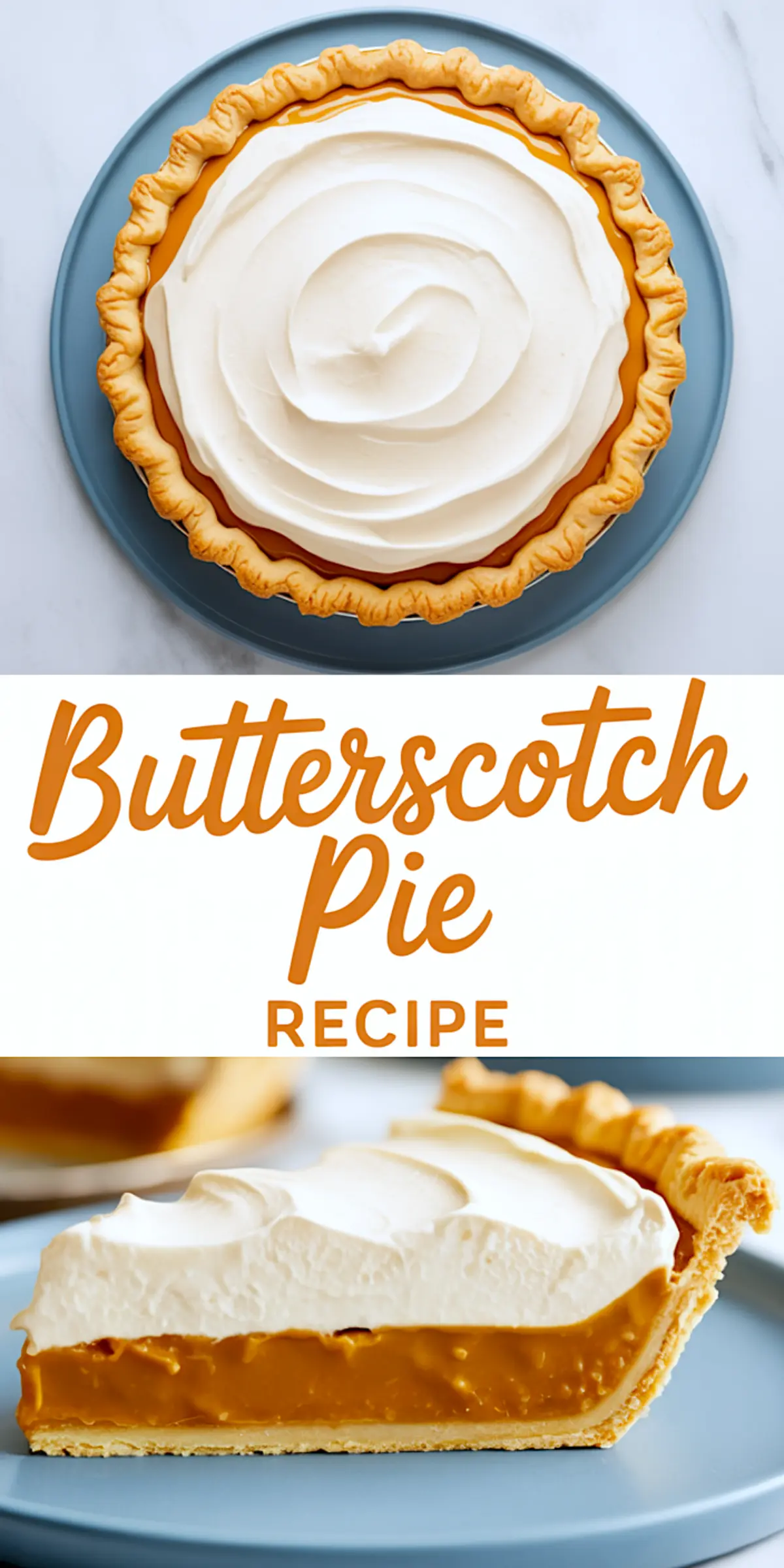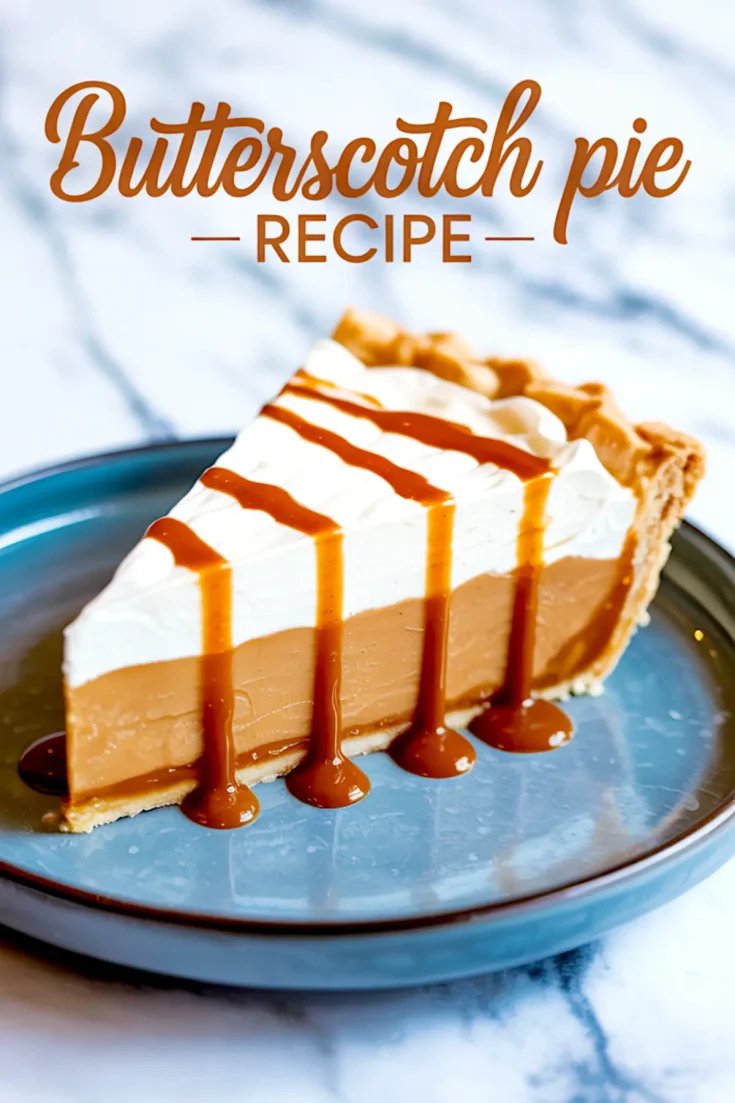There’s something grounding about a dessert that doesn’t try too hard. Butterscotch pie falls into that category. No heavy garnish, no trendy layers. Just a custard that speaks through deep brown sugar, a golden crust that shatters softly beneath the fork, and a drizzle of caramel that melts into whipped cream like it belongs there.
This guide will walk you through every part of making homemade butterscotch pie, including tips for a smooth filling, how to avoid common mistakes, and the best way to serve and store it. You’ll also see how this recipe compares to similar old-fashioned butterscotch desserts like pudding pies and pecan pies.
The goal is simple: make a pie that slices clean, chills firm, and delivers a flavor that lingers.

Why Butterscotch Pie Deserves a Spot in Your Rotation
Butterscotch pie is often overlooked in favor of more dramatic options like banoffee pie or coconut cream pie, but it delivers something those others don’t: restraint. It relies on dark brown sugar, real milk, and egg yolks for its structure—nothing artificial, nothing loud. Just smooth custard in a crisp shell, made quietly and confidently.
I’ve made versions with extra butter, swapped the milk for cream, and even tried folding in chocolate. None of those delivered the same finish as this combination. The depth comes from the sugar, not shortcuts.
If you’re already familiar with butterscotch cheesecake or caramel pie recipes, this pie will feel like a gentler cousin. Lighter than a baked cheesecake, more elegant than a slab of pudding in a crust.
The Right Ingredients Make a Difference

You’ll start with a single pie crust. Store-bought works, but I usually keep extra rounds of my homemade pie crust in the freezer for recipes like this one pie crust recipe. The filling uses dark brown sugar, not light, to give the custard its trademark depth. Cornstarch thickens without muting the flavor.
Use whole milk—not low fat. The fat content supports the silky set, especially once chilled. I’ve tested this with half-and-half, but the result came out heavy and dulled the butterscotch. Whole milk brings balance.

For flavor, real vanilla is worth using here. You’ll also need egg yolks, butter, and a pinch of salt to round out the profile.
Some versions add a splash of bourbon. I leave it out when making this for a group, but you can include a tablespoon if serving adults who enjoy a sharper edge.
Add Texture or Keep It Smooth

This filling stands on its own, but I sometimes fold in chopped pecans or crushed toffee bits. Each brings something different. Pecans lend a nutty structure, while toffee adds a sharp crunch that softens slightly in the fridge.
Between the two, I’ve found that pecans offer better contrast to the whipped topping, especially if you use unsweetened cream. You can skip both for a fully smooth slice, especially if you’re aiming for a nostalgic butterscotch pudding pietexture.
Assembly Tips and Blind Baking Notes
Blind baking your crust is non-negotiable. A soft crust ruins the experience. Use pie weights or dried beans. I bake for 15 minutes with weights, then another 8 to 10 without. Let it cool fully before adding the filling.
I’ve seen some recipes skip the tempering step when adding egg yolks. Don’t. You’ll avoid scrambled eggs in your custard if you slowly stream a bit of hot filling into the yolks first. Then return it to the saucepan and cook it until thickened and glossy.
Stir constantly. The filling moves fast once it begins to thicken. I prefer a silicone spatula for this part—it gets into the corners and keeps the base from catching.
Once done, remove from heat and stir in the butter and vanilla. The residual heat does the work without breaking the texture.
Chill with Patience, Whip with Intention
Once the filling is in the shell, press plastic wrap directly against the surface. This keeps the top smooth and prevents a skin. Refrigerate for at least four hours.
While the pie sets, you can prepare your topping. I use lightly sweetened whipped cream with powdered sugar and vanilla. It contrasts the brown sugar and adds lift without weighing things down.
Once you’re ready to serve, drizzle with caramel or butterscotch sauce. For a polished look, zigzag from edge to edge or pool it in the center. You can use store-bought, but I often use leftover caramel from my buttermilk pie batches.
How Butterscotch Pie Compares to Similar Desserts
Many ask how this differs from maple pie or butterscotch pecan pie. The answer lies in texture and sweetness. Maple pie uses syrup, which adds sharp sweetness but lacks the weight of custard. Pecan pies tend to lean on corn syrup and eggs, making them richer but stickier.
This pie falls between both. It slices like a cream pie but offers more structure. The filling is custard-based, not gelatin-stiffened or syrup-heavy. That means it holds its shape but still melts gently on the tongue.
You could also think of it as a quieter version of a butterscotch cheesecake. The crust delivers crunch, the filling holds up without needing baking time after blind baking, and the topping adds balance rather than bulk.
Serving and Storage Advice from My Notes
I prefer serving this pie cold, but not straight from the fridge. Let it sit for about 10 to 15 minutes so the filling softens slightly. The whipped topping becomes silkier at room temp.
If you’re adding the optional crunch elements, this pause lets the flavors come forward. For texture contrast, serve with a few chopped pecans scattered around the plate.
Leftovers keep for up to two days, covered tightly. The crust may soften slightly but stays intact. Avoid freezing—it affects the custard’s integrity. If you’re looking for something more freezable, try my coconut cream pie instead coconut cream pie.
Related Recipes You May Enjoy
If you’re exploring more old-fashioned or chilled pies, you may want to try:
- Banoffee pie for a layered dessert with banana and toffee.
- Pie crust recipe to improve your base for any custard or cream pie.
Save This for Later and Share Your Thoughts

If you’re planning to bake later this week, pin this recipe now so it’s ready when you are. You’ll find it delivers the kind of result that doesn’t need a lot of fanfare.
Let me know in the comments how yours turned out. Did you use pecans, toffee, or keep it smooth? I’d love to hear what worked best in your kitchen.
Butterscotch Pie Recipe

A smooth butterscotch custard fills a flaky pie crust, topped with lightly sweetened whipped cream and finished with a caramel drizzle. For added texture, a layer of chopped toasted pecans or crushed toffee bits can be sprinkled into the filling before chilling. The combination of rich brown sugar flavor, crisp crust, and cool whipped topping makes each bite balanced and satisfying.
Ingredients
- For the Pie Crust:
- 1 9-inch unbaked pie crust (store-bought or homemade)
- For the Butterscotch Filling:
- 1 cup packed dark brown sugar
- 1/4 cup cornstarch
- 1/2 teaspoon salt
- 2 1/2 cups whole milk
- 4 large egg yolks
- 1/4 cup unsalted butter
- 2 teaspoons vanilla extract
- 1/2 cup chopped toasted pecans or crushed toffee bits (like Heath bar), optional
- FOR THE WHIPPED TOPPING:
- 1 1/4 cups heavy cream
- 2 tablespoons powdered sugar
- 1 teaspoon vanilla extract
- FOR THE OPTIONAL DRIZZLE (FOR SERVING):
- 1/2 cup caramel sauce or butterscotch sauce (store-bought or homemade)
Instructions
- BLIND BAKE THE CRUST: Preheat the oven to 375°F (190°C). Roll out the pie dough into a 9-inch pie plate and trim and crimp the edges. Line the crust with parchment paper and fill with pie weights or dried beans. Bake for 15 minutes, then remove the weights and bake for an additional 8 to 10 minutes until the crust is lightly golden. Let the crust cool completely before adding the filling.
- MAKE THE BUTTERSCOTCH FILLING: In a medium saucepan, whisk together the brown sugar, cornstarch, and salt. Gradually add the milk, whisking to combine smoothly. In a separate bowl, whisk the egg yolks. Cook the brown sugar mixture over medium heat, stirring constantly, until it thickens and starts to bubble, about 5 to 7 minutes. Slowly whisk 1/2 cup of the hot mixture into the egg yolks to temper, then return the egg yolk mixture to the saucepan. Continue cooking for another 2 to 3 minutes, stirring constantly, until the filling is thick and creamy. Remove from heat and stir in the butter and vanilla until fully blended and smooth.
- ADD OPTIONAL CRUNCH: If using, stir the chopped toasted pecans or crushed toffee bits into the warm butterscotch filling. Pour the filling into the cooled pie crust and smooth the top with a spatula.
- CHILL: Cover the pie with plastic wrap, pressing it gently onto the surface of the filling to prevent a skin from forming. Refrigerate the pie for at least 4 hours or overnight until the filling is fully set and firm.
- WHIP AND TOP: In a chilled mixing bowl, whip the heavy cream, powdered sugar, and vanilla extract until soft peaks form. Spread the whipped cream evenly over the chilled pie using a spatula or spoon.
- DRIZZLE: Just before serving, drizzle caramel or butterscotch sauce over the whipped topping. Use a spoon to apply a smooth stream or create a zigzag pattern for a finished look.
Notes
Toffee bits provide a sweet, crisp contrast while pecans add a nutty crunch—both are optional and can be omitted for a fully smooth filling. Store the pie covered in the refrigerator for up to two days. Use homemade or high-quality store-bought caramel for best results.
Nutrition Information
Yield
12Serving Size
1Amount Per Serving Calories 442Total Fat 26gSaturated Fat 13gTrans Fat 0gUnsaturated Fat 12gCholesterol 122mgSodium 310mgCarbohydrates 48gFiber 1gSugar 33gProtein 6g

